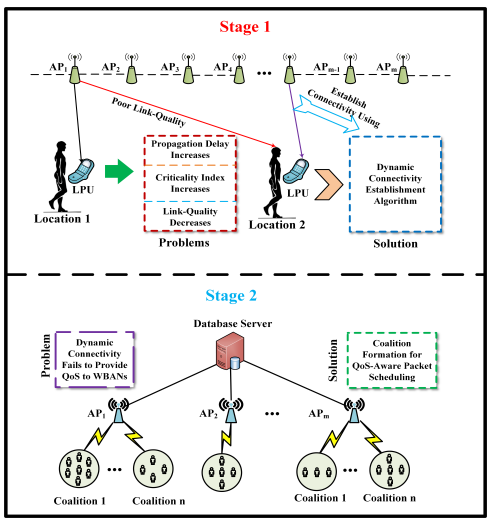Dynamic Connectivity Establishment and Cooperative Scheduling for QoS-Aware Wireless Body Area Networks
Objective
The objective of this project is, WBANs are inherently mobile in nature, a WBAN architecture inherits the traits of a group-based model, in which each WBAN is composed of several heterogeneous body sensors. Group-based mobility and changes in the body posture of WBANs have serious implications on the performance of WBAN communication, especially connectivity between a WBAN and an AP.
Abstract
In this project, in a hospital environment, the total number of Wireless Body Area Network (WBAN) equipped patients requesting ubiquitous healthcare services in an area increases significantly. Therefore, increased traffic load and group-based mobility of WBANs degrades the performance of each WBAN significantly, concerning service delay and network throughput. In addition, the mobility of WBANs affects connectivity between a WBAN and an Access Point (AP) dynamically, which affects the variation in link quality significantly.
To address the connectivity problem and provide Quality of Services (QoS) in the network, we propose a dynamic connectivity establishment and cooperative scheduling scheme, which minimizes the packet delivery delay and maximizes the network throughput. First, to secure the reliable connectivity among WBANs and APs dynamically, we formulate a selection parameter using a price-based approach. Thereafter, we formulate a utility function for the WBANs to offer QoS using a coalition game-theoretic approach.
We study the performance of the proposed approach holistically, based on different network parameters. We also compare the performance of the proposed scheme with the existing state-of-the-art.
Keywords: Wireless Body Area Network, Biomedical Monitoring, Smart Health, QoS, Cooperative Packet Scheduling, Dynamic Connectivity Establishment, Coalition Game Theory, Performance Analysis.
NOTE: Without the concern of our team, please don't submit to the college. This Abstract varies based on student requirements.
Block Diagram

Specifications
HARDWARE SPECIFICATIONS:
System: Pentium IV 2.4 GHz.
Hard Disk: 40 GB.
Floppy Drive: 1.44 Mb.
Monitor: 15 VGA Colour.
Mouse : Logitech.
Ram: 512 Mb.
SOFTWARE SPECIFICATIONS:
Operating system: Windows XP/7/LINUX.
Implementation: NS2
NS2 Version: NS2.2.34
Front End: OTCL (Object Oriented Tool Command Language)
Tool: Fedora (To simulate in Linux OS)
Learning Outcomes
- What is Tomcat server and how they can work?
- What is Wireless Body Area Network?
- What is QOS?
- What is Dynamic Connectivity Establishment?
- What is Game Theory?
- What is Wireless Body Area Network?
- What type of technology versions is used?
- Data Parsing Front-End to Back-End.
- Need of Eclipse-IDE to develop a web application.
- Working Procedure.
- Testing Techniques.
- Error Correction mechanisms.
- How to run and deploy the applications?
- Introduction to basic technologies used for.
- How project works?
- Input and Output modules.
- How to test the project based on user inputs and observe the output?
- Practical exposure to software tools and solution providing for real time problems working with team/ individual work on Creative ideas.
- Learn about types of algorithms and how to use?
- Project Development Skills:
- Problem analysing skills.
- Problem solving skills.
- Creativity and imaginary skills.
- Programming skills.
- Deployment.
- Testing skills.
- Debugging skills.
- Project presentation skills.
- Thesis writing skills.





 Paper Publishing
Paper Publishing
